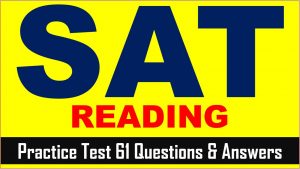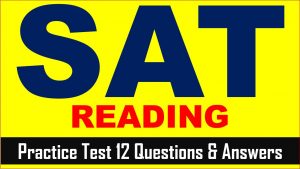SAT (Scholastic Assessment Test) is a standard test, used for taking admission to undergraduate programs of universities or colleges of the United States. SAT is developed and published by the College Board, an organization in the United States, administered by the Educational Testing Service. In this article of AKVTutorials, you will get SAT Reading Prep Test 37 | SAT 2024 Online Tutor AMBiPi.
SAT Reading Practice Passage
This passage is adapted from Jeffrey Mervis, “Why Null Results Rarely See the Light of Day.” ©2014 by American Association for the Advancement of Science.
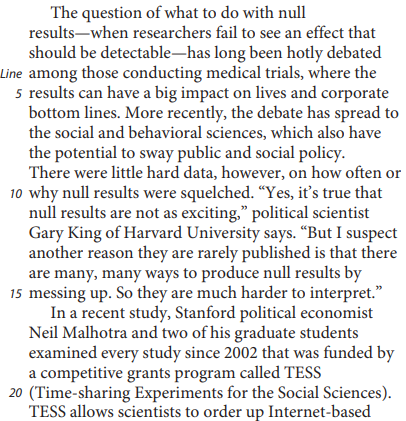
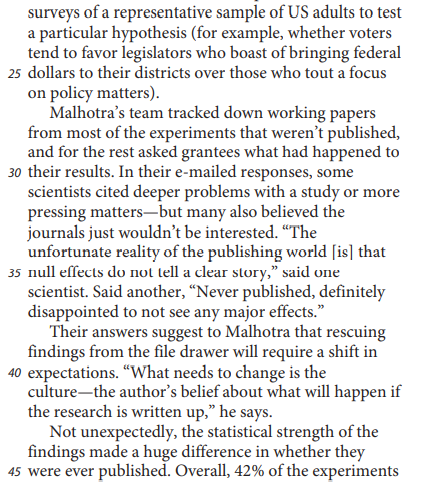
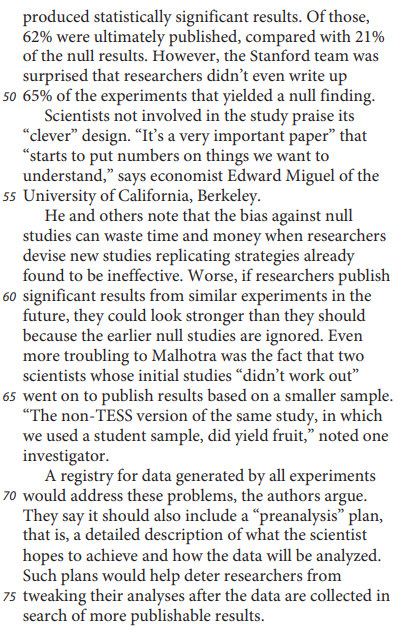
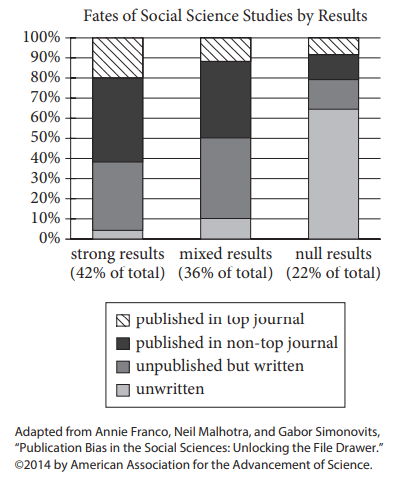
SAT Reading Comprehension Practice Test Questions
SAT Practice Test 37 Question No 1
The passage primarily serves to
Option A: discuss recent findings concerning scientific studies and dispute a widely held belief about the publication of social science research.
Option B: explain a common practice in the reporting of research studies and summarize a study that provides support for a change to that practice.
Option C: describe the shortcomings in current approaches to medical trials and recommend the implementation of a government database.
Option D: provide context as part of a call for stricter controls on social science research and challenge publishers to alter their mindsets.
SAT Practice Test 37 Answer No 1
Show/Hide Answer
Option B :
The first paragraph describes the widespread practice of not reporting null results, or results in which researchers fail to see an effect that should be detectable. The second through sixth paragraphs discuss a study that examined how scientists have dealt with null results. The seventh and eighth paragraphs discuss the negative consequences that null results pose for future research and the possible creation of a registry for all data produced by research studies, reported and unreported alike, as a remedy for those consequences. Therefore, the purpose of the passage as a whole is to explain a common practice in the reporting of research studies and summarize a study that provides support for a change to that practice.
Choice A is incorrect because the passage doesn’t dispute a widely held belief about the publication of social science research; rather, it suggests a solution to deal with a long-debated problem. Choice C is incorrect because while the passage hints at possible shortcomings in research trials, it doesn’t describe them in detail; because it addresses other kinds of research besides medical trials; and because it doesn’t call for a government database, specifically. Choice D is incorrect because the passage calls for changes to the reporting of research results, rather than to research methodology itself, and because it doesn’t address the publishers of research at all.
SAT Practice Test 37 Question No 2
As used in line 21, “allows” most nearly means
Option A: admits.
Option B: tolerates.
Option C: grants.
Option D: enables.
SAT Practice Test 37 Answer No 2
Show/Hide Answer
Option D :
The second paragraph states that “TESS allows scientists to order up Internet-based surveys.” In the context of the service that the TESS program provides to scientists, “allows” most nearly means enables.
Choices A, B, and C are incorrect because in the context of the passage’s discussion of TESS, “allows” most nearly means enables, not admits (choice A), tolerates (choice B), or grants (choice C).
SAT Practice Test 37 Question No 3
As used in line 43, “strength” most nearly means
Option A: attribution.
Option B: exertion.
Option C: toughness.
Option D: significance.
SAT Practice Test 37 Answer No 3
Show/Hide Answer
Option D :
The fifth paragraph of the passage addresses the “statistical strength” of certain scientific findings. In this context, “strength” most nearly means significance, or importance.
Choices A, B, and C are incorrect because in the context of the statistical importance of scientific findings, “strength” most nearly means significance, not attribution (choice A), exertion (choice B), or toughness (choice C).
SAT Practice Test 37 Question No 4
The passage indicates that a problem with failing to document null results is that
Option A: the results of related studies will be misleading.
Option B: researchers may overlook promising areas of study.
Option C: mistakes in the collection of null results may be overlooked.
Option D: the bias against null results will be disregarded.
SAT Practice Test 37 Answer No 4
Show/Hide Answer
Option A :
The seventh paragraph discusses the negative consequences of not publishing null results, emphasizing that “worse, if researchers publish significant results from similar experiments in the future, they could look stronger than they should because the earlier null studies are ignored.” In other words, failing to document null results means that the results of later, related studies will not be as accurate as they appear.
Choices B, C, and D are incorrect because the passage does not indicate that failing to document null results can cause promising areas of research to be overlooked (choice B), cause errors in data collection practices that lead to null results being overlooked (choice C), or lessen bias against null results (choice D).
SAT Practice Test 37 Question No 5
Which choice provides the best evidence for the answer to the previous question?
Option A: Lines 38-40 (“Their… expectations”)
Option B: Lines 48-50 (“However… finding”)
Option C: Lines 56-59 (“He and… ineffective”)
Option D: Lines 59-62 (“Worse… ignored”)
SAT Practice Test 37 Answer No 5
Show/Hide Answer
Option D :
The previous question asks what the passage indicates could result from failing to document null results. The answer, that the results of future studies will be misleading, is best supported in the seventh paragraph: “Worse, if researchers publish significant results from similar experiments in the future, they could look stronger than they should because the earlier null studies are ignored.”
Choices A, B, and C are incorrect because the cited lines don’t support the answer to the previous question. Instead, choice A suggests how the findings of a study about null results may affect existing beliefs about such results; choice B explains how infrequently null results had been written up, according to Malhotra’s study; and choice C illustrates a problem resulting from the failure to document null results, but one that is unrelated to the fact that this documentation failure may make the results of future, related studies appear more valid than they are.
SAT Practice Test 37 Question No 6
Based on the passage, to which of the following hypothetical situations would Malhotra most strongly object?
Option A: A research team refuses to publish null results in anything less than a top journal.
Option B: A research team excludes the portion of data that produced null results when reporting its results in a journal.
Option C: A research team unknowingly repeats a study that produced null results for another research team.
Option D: A research team performs a follow-up study that expands the scope ofan initial study that produced null results.
SAT Practice Test 37 Answer No 6
Show/Hide Answer
Option B :
The last two sentences of the seventh paragraph identify a particular research scenario that Malhotra uncovered in his study: “Even more troubling to Malhotra was the fact that two scientists whose initial studies ‘didn’t work out’ went on to publish results based on a smaller sample. ‘The non-TESS version of the same study, in which we used a student sample, did yield fruit,’ noted one investigator.” Since Malhotra especially objected to these researchers’ suppression of data that produced null results and their subsequent publication of related data that were statistically significant, it can be inferred that the hypothetical situation to which he would most strongly object is one in which researchers publish their study results in a journal but exclude the portion of data that produced null results.
Choices A and D are incorrect because the seventh paragraph, which identifies a research scenario that Malhotra disapproved of, provides no basis for an inference that he would especially object to a team’s insisting on publishing null results in a top journal only (choice A) or a team’s expanding the scope of a study that had produced null results (choice D). Choice C is incorrect because although the first sentence of the seventh paragraph indicates Malhotra’s concern that failing to publish null results can mean that other researchers unwittingly replicate strategies that produced null results in prior studies, the paragraph goes on to identify other scenarios as being “worse” and “even more troubling” from Malhotra’s perspective.
SAT Practice Test 37 Question No 7
Which choice provides the best evidence for the answer to the previous question?
Option A: Lines 36-37 (“Said… effects”)
Option B: Lines 45-48 (“Overall… null results”)
Option C: Lines 62-68 (“Even… investigator”)
Option D: Lines 69-73 (“A registry… analyzed”)
SAT Practice Test 37 Answer No 7
Show/Hide Answer
Option C :
The previous question asks about which hypothetical situation Malhotra would most strongly object to. The answer, that he would most strongly object to researchers’ reporting their findings but failing to disclose the null results, is best supported at the end of the seventh paragraph: “Even more troubling to Malhotra was the fact that two scientists whose initial studies ‘didn’t work out’ went on to publish results based on a smaller sample. ‘The non-TESS version of the same study, in which we used a student sample, did yield fruit,’ noted one investigator.”
Choices A, B, and D are incorrect because the cited lines don’t support the answer to the previous question about which situation Malhotra would most strongly object to. Instead, they cite another researcher’s attitude toward null results from his or her own study (choice A), compare the publication rate for studies that produce null results with that for studies that produce statistically significant results (choice B), and describe the recommendation by Malhotra and his team for the creation of a database to remedy problems resulting from the nonpublication of null results (choice D).
SAT Practice Test 37 Question No 8
The last paragraph serves mainly to
Option A: propose a future research project to deal with some of the shortcomings of current publishing practices noted in the passage.
Option B: introduce a possible solution to problems discussed in the passage regarding the reporting of social science studies.
Option C: summarize the findings of a study about experimental results explained in the passage.
Option D: reinforce the importance of reexamining the results of all social science trials.
SAT Practice Test 37 Answer No 8
Show/Hide Answer
Option B :
After describing problems that could arise from the failure to report null results, the passage shifts in the last paragraph to a potential solution to such problems: “A registry for data generated by all experiments would address these problems, the authors argue.” The paragraph goes on to imply that a registry could solve such problems by deterring the suppression of null results.
Choice A is incorrect because the last paragraph proposes a “registry for data” rather than a future research project. Choice C is incorrect because the summary of the results of Malhotra’s study occurs in the fifth paragraph, not in the last. Choice D is incorrect because the last paragraph of the passage does not mention reexamining results already obtained in social science trials.
SAT Practice Test 37 Question No 9
According to the graph, social science studies yielding strong results were
Option A: unwritten over 50 percent of the time.
Option B: unpublished but written 50 percent of the time.
Option C: published in a top journal approximately 20 percent of the time.
Option D: published in a non-top journal almost 80 percent of the time.
SAT Practice Test 37 Answer No 9
Show/Hide Answer
Option C :
The far left bar of the graph pertains to social science studies that produced strong results. This bar shows that approximately 20 percent (or two full increments of 10 percent) of such studies were published in a top journal.
Choice A is incorrect because the graph shows that approximately 5 percent of social science studies that produced strong results were unwritten, rather than over 50 percent. Choice B is incorrect because the graph shows that about 30 percent of social science studies that produced strong results were unpublished but written, rather than 50 percent. Choice D is incorrect because the graph shows that slightly over 40 percent of social science studies that produced strong results were published in a non-top journal, rather than almost 80 percent.
SAT Practice Test 37 Question No 10
Which of the following statements is supported by the graph?
Option A: Studies with mixed results were just as likely to be published as they were to be left either unpublished or unwritten.
Option B: Studies with mixed results occurred more frequently than did studies with strong and null results combined.
Option C: Studies with mixed results were more likely to be published in top journals than they were to be published in non-top journals.
Option D: Studies with mixed results were the most common type of social science studies.
SAT Practice Test 37 Answer No 10
Show/Hide Answer
Option A :
The middle bar of the graph pertains to social science studies that produced mixed results. The top 50 percent of this bar represents studies that were published. The bottom 50 percent of this bar represents studies that were either unpublished or went unwritten. Since each of the two categories accounts for 50 percent of the total, it can be said that studies with mixed results were just as likely to be published as they were to be left either unpublished or unwritten.
Choice B is incorrect because the graph indicates that roughly 42 percent of social science studies produced strong results and roughly 22 percent produced null results; together, these two percentages far exceed the 36 percent accounted for by studies that produced mixed results. Choice C is incorrect because the graph shows that roughly 12 percent of studies that produced mixed results were published in top journals, well less than the percentage published in non-top journals (approximately 38 percent). Choice D is incorrect because the graph indicates that studies that produced strong results accounted for approximately 42 percent of all studies, while those that produced mixed results only accounted for around 36 percent of all studies.

